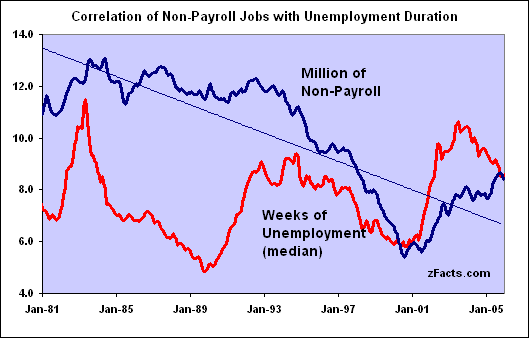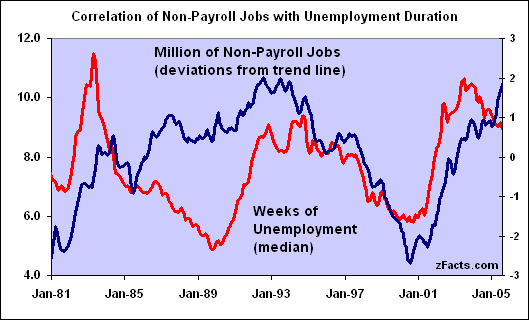|
|
|
Non-Payroll Jobs: More in Bad Times |
|
|
|
| |
More Non-Payroll Jobs Is Not a Good Sign
When then number payroll jobs fell in 2001, the number of non-payroll jobs rose. In theory it could be that good non-payroll jobs were sucking workers out of payroll jobs, but if non-payroll jobs were vacuuming up workers, it would mean jobs were easier than usual to find. In fact, as show below, shortly after jobs get hard to find, workers start taking more non-payroll jobs.
|
|
|
 |
| Source: BLS data and spreadsheet. |
| |
When it Takes Longer to Find Work, People Take More Non-Payroll Jobs
The graph above shows that when median number of weeks spend looking for work increases, the number employed in non-payroll jobs increases. The two are so perfectly synchronized in this recession, that there can be no doubt of the link.
In the past the linkage has not been as obvious. When the Bush I recession started up more slowly, the long-run decline in non-payroll jobs converted the up-swing to a level pattern. Subtracting the long-run decline from non-payroll jobs makes the correlation between the two more apparent as can be seen in the graph below.
|
|
|
 |
| Source: BLS data and spreadsheet. |
| |
Non-Payroll Jobs Include Unpaid Work in Family Enterprises.
The BLS explains that Employed persons consist of:
• All persons who did any work for pay or profit during the survey reference week.
• All persons who did at least 15 hours of unpaid work in a family-operated enterprise.
Given this definition, it is not surprising that more workers end up in non-payroll jobs when they lose their payroll jobs. In spite of this, non-payroll jobs are better than no job at all, so ignoring non-payroll jobs completely, somewhat overstates the severity of the job loss.
Non-payroll jobs are defined as total employed persons minus payroll jobs.
|
|
http://zfacts.com/p/742.html | 01/18/12 07:28 GMT
Modified: Mon, 17 Apr 2006 17:51:21 GMT
|